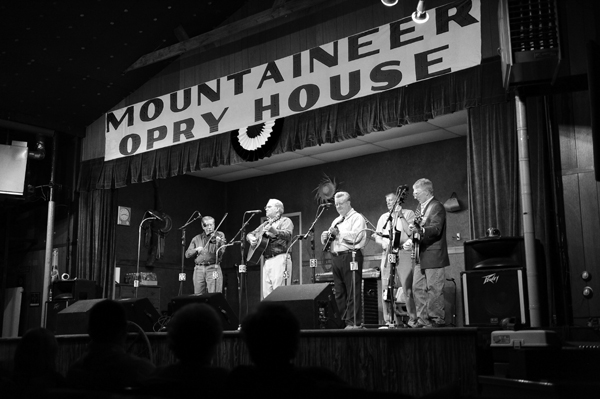Mountaineer Opry House
Milton's Home for Bluegrass Music
By Jim Gabehart
Photograph by Tyler Evert.

The Teays Valley Boys perform at the Mountaineer Opry House at Milton in 2011. From the left are Bobby Taylor, Clarence "Louie" Lewis, Willard Reynolds, Rob Ward, and Kevin Coll.
For a generation the Mountaineer Opry House in Milton has been the premier place to see bluegrass music concerts for people in western West Virginia, eastern Kentucky, and southeastern Ohio.
On July 15, 1972, the Opry House opened its doors to begin its heroic run of weekly concerts featuring country, gospel, and bluegrass music. The Mountaineer Opry was built by Paul King adjacent to his residence, located just off the Milton exit of Interstate 64 in Cabell County. Retired following 30 years as a chemical truck driver for Union Carbide’s South Charleston plant, Paul was looking for something to supplement his retirement. He had previously operated a pastry shop, owned a grocery store, and shown horses. With no prior experience in the music business, Paul enlisted the help of Eck Gibson not only to perform, but to manage the Opry House in its early years.
Such was the case for AnnabeEck Gibson was a blacksmith with the Chessie System Railroad at its Barboursville shop. He was also the leader of the Mountaineer Ramblers, a bluegrass group that included two of his sons: Curt on banjo and Troy on bass, along with Charles Reynolds on mandolin, Elmer Bird on second guitar, and Virgil “Shorty” Ross on fiddle. Many will remember Elmer Bird for his later solo career as the “Banjo Man from Turkey Creek.” [See “Elmer Bird: The Banjo Man from Turkey Creek,” by Paul Gartner; Summer 1997.]
Paul’s vision was to establish a show patterned after the Grand Ole Opry in Nashville. To properly present this show, he needed a good master of ceremonies. To fill this role, he employed local media professionals Tom Zalaski and Jim Roberts. Tom, a news anchor on WOWK-TV Channel 13, and Jim, an engineer with WCHS, shared emcee duties, while Jim also acted as sound engineer during the performances. For many years, Tom and Jim would collaborate to “warm up” the audience. The seating in the Opry House is divided into two sections with a center aisle. The two men would come out together and, after some opening banter, they would stand with one on each side of the audience and bet, usually for a penny, and pride, which of them could get their side to cheer louder.
Also involved in the early years was Bill Browning, owner of Midway Recording, a recording studio operated in Hurricane, Putnam County. A guitar player and songwriter himself, Bill is known as the composer of the popular bluegrass song, “Dark Hollow.” Bill’s nearby studio recorded and released albums by most of the local artists that appeared on the Mountaineer Opry in the mid-1970’s.
The construction and establishment of the Opry House as a viable enterprise was due in no small part to the many local bands who were willing to perform with little monetary remuneration. Bluegrass groups like Eck Gibson & the Mountaineer Ramblers, the West Virginia Gentlemen, the Teays Valley Boys, the Outdoor Plumbing Company, Frog & the Greenhorns, the Sons of Bluegrass, Kanawha Valley Bluegrass, the Laurel Mountain Boys, and Bloomin’ Grass, along with country groups like Gwen’s Country Jubilee, Denny & Phyllis Crisp, and Randy Mallory & the Country Overtones, and many others, helped to get the Opry House started and left audiences looking forward to the next Saturday night. “In its own way, it was our Grand Ole Opry, and we all were thrilled to step on that stage on Saturday night,” recalls fiddler Bobby Taylor, a former member of the Teays Valley Boys.
Annabelle's mother and father would take the trip to Ripley by wagon twice a year, in the spring and fall. They woYoung and newly formed groups found a warm and encouraging environment at the Opry House. One of these young groups that learned their craft on the Mountaineer Opry House stage was the West Virginia Gentlemen. John “Buckwheat” Green, who went on to become a touring professional as part of the Lonesome River Band, and three friends — Joe and Jerry Vance and Tim Johnson — formed their group as teenagers in the early 1970’s. They performed on a monthly basis and quickly became one of the most popular groups at the Opry House. Green remembers that Paul King saw the group’s potential and, at his own expense, hired a consultant to coach the young musicians in stage presence and presentation. “For him to do that, it showed us he really wanted to see us grow,” Green says. “We really appreciated it and have never forgotten that experience.”
With shows that typically started at 7:30 p.m. and often lasted past 11:00 p.m., and at an initial admission cost of $1.50, audiences got their money’s worth and then some.
You can read the rest of this article in this issue of Goldenseal, available in bookstores, libraries or direct from Goldenseal.